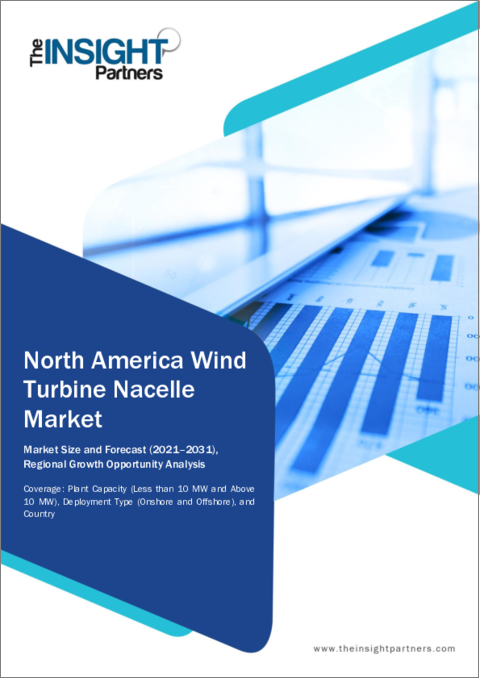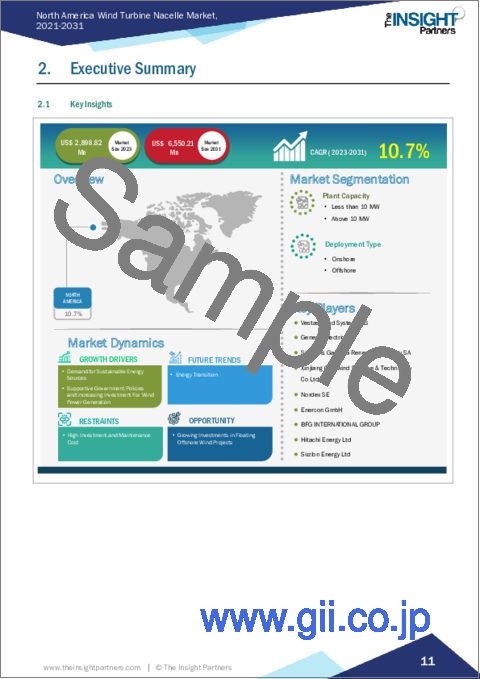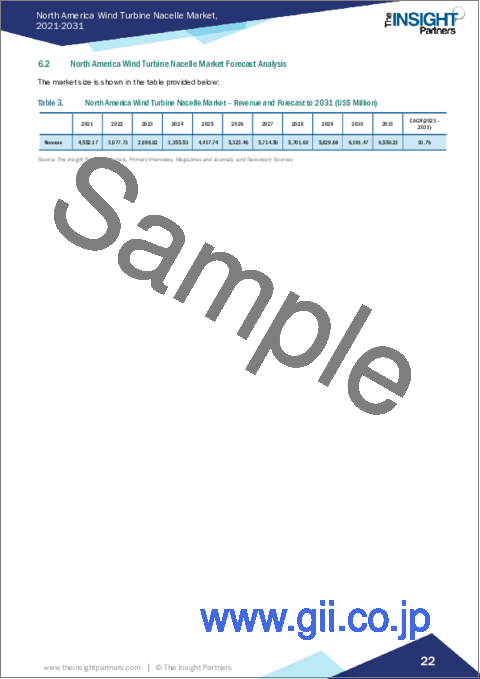|
|
市場調査レポート
商品コード
1637707
北米の風力タービン用ナセル市場:2031年までの予測 - 地域別分析 - プラント容量別、展開タイプ別North America Wind Turbine Nacelle Market Forecast to 2031 - Regional Analysis - by Plant Capacity (Less than 10 MW and Above 10 MW) and Deployment Type (Onshore and Offshore) |
||||||
|
|||||||
| 北米の風力タービン用ナセル市場:2031年までの予測 - 地域別分析 - プラント容量別、展開タイプ別 |
|
出版日: 2024年11月22日
発行: The Insight Partners
ページ情報: 英文 76 Pages
納期: 即納可能
|
全表示
- 概要
- 図表
- 目次
北米の風力タービン用ナセル市場は、2023年に28億9,882万米ドルとなり、2031年までには65億5,021万米ドルに達すると予測され、2023年から2031年までのCAGRは10.7%と推定されます。
持続可能なエネルギー源に対する需要の高まりが北米の風力タービン用ナセル市場を後押し
人口増加、都市化、急速な工業化などの要因により、発電用の持続可能なエネルギー源に対する需要が急増しています。風力発電は、増大するエネルギー需要を支えるために必要な電力の大部分を供給することができ、適切なエネルギー供給に貢献することができます。いくつかの国は、化石燃料への依存度を下げ、安定したエネルギー供給を確保するために、代替的で持続可能なエネルギー源を求めています。
国際的な洋上風力発電容量は、米国での新規設置や開発により、2020年の3,440万kWから2023年には6,430万kWへと急増しました。世界風力エネルギー協議会は、2050年までにネットゼロの目標を達成するために力を注いでいます。ネットゼロ目標を達成するために、風力発電所の新設や拡張のための多額の投資が世界的に行われています。さらに、風力発電所への資金援助が増加していることから、ナセル、ギアボックス、ローターブレード、発電機、ピッチシステム、タワーなどの風力タービン部品の需要が急増しています。
国際再生可能エネルギー機関(IREA)によると、風力エネルギーは、絶え間ない研究開発と運転コストの削減により、2000年以降急速に発展しています。例えば、陸上風力発電容量は2010年の1億7,800万kWから2020年には6億9,900万kWに増加し、洋上風力発電容量は2010年の310万kWから2020年には3,440万kWに増加しています。国際エネルギー機関(IEA)によれば、2022年の風力発電による発電量は、2021年から14%増の約265TWh増加します。このように、電力需要の増加とクリーンエネルギーへの選好の高まりは、陸上および洋上風力発電プロジェクトの数を積極的に急増させ、最終的に風力タービン用ナセル市場を牽引しています。
北米の風力タービン用ナセル市場概要
北米の風力タービン用ナセル市場は、米国、カナダ、メキシコに区分されます。北米の風力産業は、政府の規制と政策、風力発電プロジェクトへの投資の増加、風力エネルギーのコスト削減などにより、著しい成長が見込まれています。北米では、持続可能性の目標に対する消費者の意識の高まり、再生可能エネルギーと風力エネルギーの役割により、風力発電の設置が増加すると予想されます。
米国の風力エネルギーは過去5年間で記録的な成長を遂げ、米国の発電容量増加の最大の要因となっています。風力発電は、16の州で電力の約10%を供給し、アイオワ、カンザス、オクラホマ、サウスダコタ、ノースダコタでは約30%以上を供給しています。風力発電技術の性能は、生産税控除や発電コストの低下と相まって、風力発電設備の増設を加速させました。このため、北米における風力発電プロジェクト建設に向けた投資の増加が、2023年から2031年にかけて風力タービン用ナセル市場の成長を促進すると予想されます。
カナダ政府は再生可能エネルギーに投資し、先住民のパートナーと協力して大規模プロジェクトを建設しています。例えば、2022年5月、天然資源大臣は、WolumseketとNatural Forces Developmentが再生可能エネルギーと送電網近代化技術を導入するためのパートナーシップBurchill Wind Limitedに約5,000万米ドルを投資すると発表しました。2022年3月、カナダは2030年までの二酸化炭素排出削減目標を達成するため、風力・太陽光発電プロジェクトに72億米ドルを投資する計画を発表しました。
メキシコ政府は、国内の風力タービン建設に多額の投資を行っています。メキシコエネルギー協会(AMDEE)によると、メキシコの風力エネルギー部門の開発には13億米ドルの投資が割り当てられています。このように、上記のすべての要因が北米の風力タービン用ナセル市場の成長を後押ししています。
北米の風力タービン用ナセル市場の収益と2031年までの予測(百万米ドル)
北米の風力タービン用ナセル市場セグメンテーション
北米の風力タービン用ナセル市場は、プラント容量、展開タイプ、国別に分類されます。
プラント容量に基づいて、北米の風力タービン用ナセル市場は10MW未満と10MW以上に区分されます。2023年の市場シェアは10MW以上が大きくなりました。
北米の風力タービン用ナセル市場は、設置タイプ別に陸上と洋上に区分されます。2023年の市場シェアは陸上セグメントが大きくなりました。
国別では、北米の風力タービン用ナセル市場は米国、カナダ、メキシコに区分されます。2023年の北米の風力タービン用ナセル市場シェアは米国が独占しました。
BFG International Group、ENERCON GmbH、General Electric Co、Hitachi Energy Ltd、Nordex SE、Siemens Gamesa Renewable Energy SA、Suzlon Energy Ltd、Vestas Wind Systems AS、Xinjiang Goldwind Science &Technology Co Ltdは、北米の風力タービン用ナセル市場で事業を展開している主要企業です。
目次
第1章 イントロダクション
第2章 エグゼクティブサマリー
- 主要洞察
- 市場の魅力
第3章 調査手法
- 調査範囲
- 2次調査
- 1次調査
第4章 北米の風力タービン用ナセルの市場情勢
- エコシステム分析
- 原材料サプライヤー
- ナセルメーカー
- エンドユーザー
- バリューチェーンのベンダー一覧
第5章 北米の風力タービン用ナセル市場:主要市場力学
- 市場促進要因
- 持続可能なエネルギー源に対する需要の高まり
- 風力発電に対する政府の支援政策
- 市場抑制要因
- 高い投資コストとメンテナンスコスト
- 市場機会
- 浮体式洋上風力発電プロジェクトへの投資の増加
- 今後の動向
- エネルギー転換
- 促進要因と抑制要因の影響
第6章 風力タービン用ナセル市場:北米分析
- 北米の風力タービン用ナセル市場の収益、2021年~2031年
- 北米の風力タービン用ナセル市場の予測分析
第7章 北米の風力タービン用ナセル市場分析:プラント容量別
- 10MW未満
- 10MW以上
第8章 北米の風力タービン用ナセル市場分析:展開タイプ別
- オンショア
- オフショア
第9章 北米の風力タービン用ナセル市場:国別分析
- 米国
- カナダ
- メキシコ
第10章 競合情勢
- 企業のポジショニングと集中度
第11章 業界情勢
- 市場イニシアティブ
第12章 企業プロファイル
- Siemens Gamesa Renewable Energy SA
- General Electric Co
- Nordex SE
- ENERCON GmbH
- Vestas Wind Systems AS
- Xinjiang Goldwind Science & Technology Co Ltd
- Hitachi Energy Ltd
- Suzlon Energy Ltd
- BFG International Group
第13章 付録
List Of Tables
- Table 1. North America Wind Turbine Nacelle Market Segmentation
- Table 2. List of Vendors
- Table 3. North America Wind Turbine Nacelle Market - Revenue and Forecast to 2031 (US$ Million)
- Table 4. North America Wind Turbine Nacelle Market - Revenue and Forecast to 2031 (US$ Million) - by Plant Capacity
- Table 5. North America Wind Turbine Nacelle Market - Revenue and Forecast to 2031 (US$ Million) - by Deployment Type
- Table 6. North America Wind Turbine Nacelle Market - Revenue and Forecast to 2031 (US$ Million) - by Country
- Table 7. US: Wind Turbine Nacelle Market - Revenue and Forecast to 2031 (US$ Million) - by Plant Capacity
- Table 8. US: Wind Turbine Nacelle Market - Revenue and Forecast to 2031 (US$ Million) - by Deployment Type
- Table 9. Canada: Wind Turbine Nacelle Market - Revenue and Forecast to 2031 (US$ Million) - by Plant Capacity
- Table 10. Canada: Wind Turbine Nacelle Market - Revenue and Forecast to 2031 (US$ Million) - by Deployment Type
- Table 11. Mexico: Wind Turbine Nacelle Market - Revenue and Forecast to 2031 (US$ Million) - by Plant Capacity
- Table 12. Mexico: Wind Turbine Nacelle Market - Revenue and Forecast to 2031 (US$ Million) - by Deployment Type
List Of Figures
- Figure 1. North America Wind Turbine Nacelle Market Segmentation, by Country
- Figure 2. North America Wind Turbine Nacelle Market - Key Market Dynamics
- Figure 3. Impact Analysis of Drivers and Restraints
- Figure 4. North America Wind Turbine Nacelle Market Revenue (US$ Million), 2021-2031
- Figure 5. North America Wind Turbine Nacelle Market Share (%) - by Plant Capacity (2023 and 2031)
- Figure 6. Less than 10 MW: Wind Turbine Nacelle Market - Revenue and Forecast to 2031 (US$ Million)
- Figure 7. Above 10 MW: Wind Turbine Nacelle Market - Revenue and Forecast to 2031 (US$ Million)
- Figure 8. North America Wind Turbine Nacelle Market Share (%) - by Deployment Type (2023 and 2031)
- Figure 9. Onshore: Wind Turbine Nacelle Market - Revenue and Forecast to 2031 (US$ Million)
- Figure 10. Offshore: Wind Turbine Nacelle Market - Revenue and Forecast to 2031 (US$ Million)
- Figure 11. North America Wind Turbine Nacelle Market, By Key Country - Revenue (2023) (US$ Million)
- Figure 12. North America Wind Turbine Nacelle Market Breakdown, by Key Countries, 2023 and 2031 (%)
- Figure 13. US: Wind Turbine Nacelle Market - Revenue and Forecast to 2031 (US$ Million)
- Figure 14. Canada: Wind Turbine Nacelle Market - Revenue and Forecast to 2031 (US$ Million)
- Figure 15. Mexico: Wind Turbine Nacelle Market - Revenue and Forecast to 2031 (US$ Million)
- Figure 16. Company Positioning & Concentration
The North America wind turbine nacelle market was valued at US$ 2,898.82 million in 2023 and is expected to reach US$ 6,550.21 million by 2031; it is estimated to register a CAGR of 10.7% from 2023 to 2031.
Rising Demand for Sustainable Energy Sources Fuels North America Wind Turbine Nacelle Market
Factors such as population growth, urbanization, and rapid industrialization have surged the demand for sustainable energy sources for power generation. Wind power can offer a significant portion of the electricity required to support the growing energy demand and can contribute to the proper energy supply. Several nations are looking for alternative and sustainable energy sources to lower their dependency on fossil fuels, ensuring a constant energy supply.
The international offshore wind capacity surged from 34.4 GW in 2020 to 64.3 GW in 2023, owing to the new installations and developments in the US. The Global Wind Energy Council is putting efforts to achieve a net zero target by 2050. Substantial investments are being made globally for the new assembly and expansion of wind farms in order to achieve the net zero targets. Furthermore, the rising financing aid for wind farms has surged the demand for wind turbine components such as nacelle, gearbox, rotor blades, generator, pitch system, and tower.
As per the International Renewable Energy Agency (IREA), wind energy has developed rapidly since 2000, owing to constant R&D and reduction in operational costs. For instance, onshore wind capacity increased from 178 GW in 2010 to 699 GW in 2020, whereas offshore wind capacity increased from 3.1 GW in 2010 to 34.4 GW in 2020. As per the International Energy Agency, in 2022, electricity generation from wind increased by almost ~265 TWh, which is 14% up from 2021. Thus, the rising demand for electricity and increased preferences for clean energy have positively surged the number of onshore and offshore wind energy projects, ultimately driving the wind turbine nacelle market.
North America Wind Turbine Nacelle Market Overview
The North America wind turbine nacelle market is segmented into the US, Canada, and Mexico. The North American wind industry is expected to register remarkable growth owing to supportive government regulations, favorable policies, increasing investment in wind power projects, and reduced cost of wind energy. In North America, the growing consumer awareness toward sustainability goals and the role of renewable energy and wind energy are expected to increase wind power installations.
Wind energy in the US grew at a record growth in the last five years, which represents the largest source of new additions to the US electric-generating capacity. Wind power provides ~10% of electricity in 16 states and over ~30% in Iowa, Kansas, Oklahoma, South Dakota, and North Dakota. The performance of wind energy technologies, coupled with the production tax credit and lower cost of power generation, accelerated the addition of wind energy capacity. Thus, a rise in investment toward building wind power projects in North America is expected to drive the growth of the wind turbine nacelle market from 2023 to 2031.
The Canadian government is investing in renewable energy and working with indigenous partners to build major projects. For instance, in May 2022, the Minister of Natural Resources announced an investment of ~US$ 50 million for the Burchill Wind Limited partnership between Wolumseket and Natural Forces Development to deploy renewable energy and grid modernization technologies. In March 2022, Canada announced its plans to invest US$ 7.2 billion in wind and solar projects to meet carbon emissions reduction targets by 2030.
The government of Mexico has invested a significant amount in the construction of wind turbines in the country. According to the Asociacion Mexicana de Energia Eolica (AMDEE), an investment of ~US$ 1.3 billion has been allocated to develop the Mexican wind energy sector. Thus, all the above factors are fueling the growth of the North America wind turbine nacelle market.
North America Wind Turbine Nacelle Market Revenue and Forecast to 2031 (US$ Million)
North America Wind Turbine Nacelle Market Segmentation
The North America wind turbine nacelle market is categorized into plant capacity, deployment type, and country.
Based on plant capacity, the North America wind turbine nacelle market is segmented into less than 10 MW and above 10 MW. The above 10 MW segment held a larger market share in 2023.
Based on deployment type, the North America wind turbine nacelle market is segmented into onshore and offshore. The onshore segment held a larger market share in 2023.
By country, the North America wind turbine nacelle market is segmented into the US, Canada, and Mexico. The US dominated the North America wind turbine nacelle market share in 2023.
BFG International Group, ENERCON GmbH, General Electric Co, Hitachi Energy Ltd, Nordex SE, Siemens Gamesa Renewable Energy SA, Suzlon Energy Ltd, Vestas Wind Systems AS, and Xinjiang Goldwind Science & Technology Co Ltd are some of the leading companies operating in the North America wind turbine nacelle market.
Table Of Contents
1. Introduction
- 1.1 The Insight Partners Research Report Guidance
- 1.2 Market Segmentation
2. Executive Summary
- 2.1 Key Insights
- 2.2 Market Attractiveness
3. Research Methodology
- 3.1 Coverage
- 3.2 Secondary Research
- 3.3 Primary Research
4. North America Wind Turbine Nacelle Market Landscape
- 4.1 Overview
- 4.2 Ecosystem Analysis
- 4.2.1 Raw Material Suppliers:
- 4.2.2 Nacelle Manufacturers
- 4.2.3 End Users
- 4.2.4 List of Vendors in the Value Chain
5. North America Wind Turbine Nacelle Market - Key Market Dynamics
- 5.1 Market Drivers
- 5.1.1 Rising Demand for Sustainable Energy Sources
- 5.1.2 Supportive Government Policies for Wind Power Generation
- 5.2 Market Restraints
- 5.2.1 High Investment and Maintenance Cost
- 5.3 Market Opportunities
- 5.3.1 Growing Investments in Floating Offshore Wind Projects
- 5.4 Future Trends
- 5.4.1 Energy Transition
- 5.5 Impact of Drivers and Restraints:
6. Wind Turbine Nacelle Market - North America Analysis
- 6.1 North America Wind Turbine Nacelle Market Revenue (US$ Million), 2021-2031
- 6.2 North America Wind Turbine Nacelle Market Forecast Analysis
7. North America Wind Turbine Nacelle Market Analysis - by Plant Capacity
- 7.1 Less than 10 MW
- 7.1.1 Overview
- 7.1.2 Less than 10 MW: Wind Turbine Nacelle Market - Revenue and Forecast to 2031 (US$ Million)
- 7.2 Above 10 MW
- 7.2.1 Overview
- 7.2.2 Above 10 MW: Wind Turbine Nacelle Market - Revenue and Forecast to 2031 (US$ Million)
8. North America Wind Turbine Nacelle Market Analysis - by Deployment Type
- 8.1 Onshore
- 8.1.1 Overview
- 8.1.2 Onshore: Wind Turbine Nacelle Market - Revenue and Forecast to 2031 (US$ Million)
- 8.2 Offshore
- 8.2.1 Overview
- 8.2.2 Offshore: Wind Turbine Nacelle Market - Revenue and Forecast to 2031 (US$ Million)
9. North America Wind Turbine Nacelle Market - Country Analysis
- 9.1 North America Wind Turbine Nacelle Market Overview
- 9.1.1 North America Wind Turbine Nacelle Market - Revenue and Forecast Analysis - by Country
- 9.1.1.1 North America Wind Turbine Nacelle Market - Revenue and Forecast Analysis - by Country
- 9.1.1.2 US: Wind Turbine Nacelle Market - Revenue and Forecast to 2031 (US$ Million)
- 9.1.1.2.1 US: Wind Turbine Nacelle Market Breakdown, by Plant Capacity
- 9.1.1.2.2 US: Wind Turbine Nacelle Market Breakdown, by Deployment Type
- 9.1.1.3 Canada: Wind Turbine Nacelle Market - Revenue and Forecast to 2031 (US$ Million)
- 9.1.1.3.1 Canada: Wind Turbine Nacelle Market Breakdown, by Plant Capacity
- 9.1.1.3.2 Canada: Wind Turbine Nacelle Market Breakdown, by Deployment Type
- 9.1.1.4 Mexico: Wind Turbine Nacelle Market - Revenue and Forecast to 2031 (US$ Million)
- 9.1.1.4.1 Mexico: Wind Turbine Nacelle Market Breakdown, by Plant Capacity
- 9.1.1.4.2 Mexico: Wind Turbine Nacelle Market Breakdown, by Deployment Type
- 9.1.1 North America Wind Turbine Nacelle Market - Revenue and Forecast Analysis - by Country
10. Competitive Landscape
- 10.1 Company Positioning & Concentration
11. Industry Landscape
- 11.1 Overview
- 11.2 Market Initiative
12. Company Profiles
- 12.1 Siemens Gamesa Renewable Energy SA
- 12.1.1 Key Facts
- 12.1.2 Business Description
- 12.1.3 Products and Services
- 12.1.4 Financial Overview
- 12.1.5 SWOT Analysis
- 12.1.6 Key Developments
- 12.2 General Electric Co
- 12.2.1 Key Facts
- 12.2.2 Business Description
- 12.2.3 Products and Services
- 12.2.4 Financial Overview
- 12.2.5 SWOT Analysis
- 12.2.6 Key Developments
- 12.3 Nordex SE
- 12.3.1 Key Facts
- 12.3.2 Business Description
- 12.3.3 Products and Services
- 12.3.4 Financial Overview
- 12.3.5 SWOT Analysis
- 12.3.6 Key Developments
- 12.4 ENERCON GmbH
- 12.4.1 Key Facts
- 12.4.2 Business Description
- 12.4.3 Products and Services
- 12.4.4 Financial Overview
- 12.4.5 SWOT Analysis
- 12.4.6 Key Developments
- 12.5 Vestas Wind Systems AS
- 12.5.1 Key Facts
- 12.5.2 Business Description
- 12.5.3 Products and Services
- 12.5.4 Financial Overview
- 12.5.5 SWOT Analysis
- 12.5.6 Key Developments
- 12.6 Xinjiang Goldwind Science & Technology Co Ltd
- 12.6.1 Key Facts
- 12.6.2 Business Description
- 12.6.3 Products and Services
- 12.6.4 Financial Overview
- 12.6.5 SWOT Analysis
- 12.6.6 Key Developments
- 12.7 Hitachi Energy Ltd
- 12.7.1 Key Facts
- 12.7.2 Business Description
- 12.7.3 Products and Services
- 12.7.4 Financial Overview
- 12.7.5 SWOT Analysis
- 12.7.6 Key Developments
- 12.8 Suzlon Energy Ltd
- 12.8.1 Key Facts
- 12.8.2 Business Description
- 12.8.3 Products and Services
- 12.8.4 Financial Overview
- 12.8.5 SWOT Analysis
- 12.8.6 Key Developments
- 12.9 BFG International Group
- 12.9.1 Key Facts
- 12.9.2 Business Description
- 12.9.3 Products and Services
- 12.9.4 Financial Overview
- 12.9.5 SWOT Analysis
- 12.9.6 Key Developments
13. Appendix
- 13.1 About The Insight Partners





